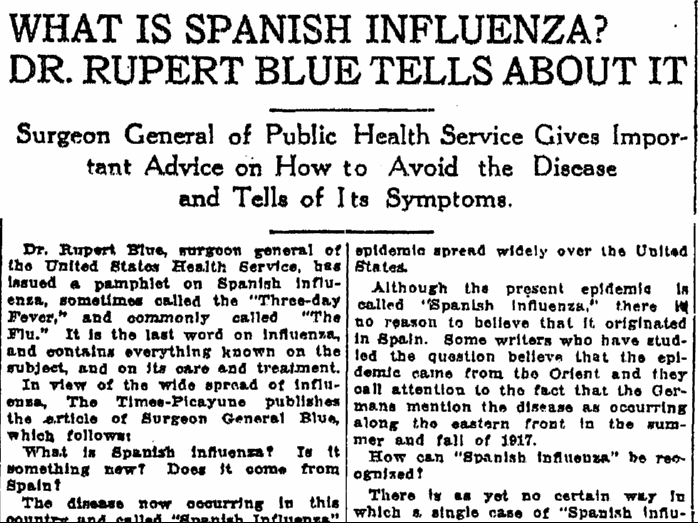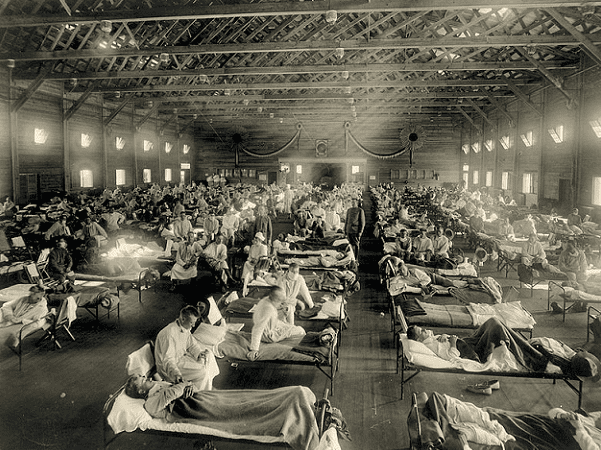Introduction: In this article, Gena Philibert-Ortega researches old newspaper articles to learn about the 1918 Spanish Flu Pandemic, a three-year disaster that killed approximately 50 million people worldwide and unquestionably affected the lives of any of your ancestors living in the years 1918-1920. Gena is a genealogist and author of the book “From the Family Kitchen.”
Influenza is a disease, makes you weak all in your knees;
‘Tis a fever ev’ybody sure does dread;
Puts a pain in ev’y bone, a few days an’ you are gone
To a place in de groun’ called de grave.
—“Influenza,” lyrics found on American Memory: the John and Ruby Lomax 1939 Southern States Recording Trip. Song sung by Ace Johnson, Clemens State Farm, Brazoria, Texas, April 16, 1939.
Earlier this year, despite having had a flu shot, I ended up catching the flu. Anyone who has had the flu knows how truly miserable it is. When you are suffering from it, you can easily understand how someone could die from its symptoms. Although still deadly, the flu does not strike the terror in people’s minds that it once did. In fact many people take a wait and see approach, frequently opting not to get the yearly influenza vaccination shot.
When many people think of our ancestors and the flu, they automatically think of the 1918 Spanish flu pandemic—and with good reason. This was one of the deadliest flu pandemics in history.

From January 1918 to December 1920, this flu pandemic killed approximately 50 million people worldwide, nearly 675,000 in the United States alone.[i] By contrast, 16 million lives were lost during World War I, which was still ongoing during the Spanish flu pandemic’s first year. Why was this flu different from previous forms of influenza? One significant difference in this deadly strain was that young adults were affected just as much as the usual at-risk groups: young children and the elderly.[ii]
This influenza pandemic touched everyone’s lives whether they came down with the virus or not. Efforts to curb the spread of the flu disaster included requiring people to wear facemasks, and discouraging public meetings. The committee of the American Public Health Association decreed that non-essential meetings and gatherings in crowded rooms were dangerous. Some of the APHA recommendations included the closing of “saloons, dance halls, and cinemas.”[iii]
The implementation of these public safety health precautions shows how seriously the influenza pandemic was taken. A startling example of this is described in the following article from a 1918 Washington newspaper, reporting that a public health officer shot a person on the street who refused to don a mask.
The vast movement of troops caused by World War I meant that an illness that would normally be quickly contained instead had worldwide consequences. While the 1918 pandemic is the one that often gets remembered, there have been other epidemics including those of a more recent nature, like the recent Swine Flu. There is no doubt that the 1918 pandemic wasn’t the only one that may have affected your family. According to the website flu.gov there have been four flu pandemics since 1918.[i]
Do you have an ancestor who had the flu during the Spanish flu pandemic? Want to learn more about the history of that outbreak? Good sources for researching historical epidemics are the books Encyclopedia of Plague and Pestilence: From Ancient Times to the Present by George Childs Kohn, and America’s Forgotten Epidemic: The Influenza of 1918 by Alfred W. Crosby.
Don’t forget to search for old newspaper articles about the flu on GenealogyBank. By searching on the word “influenza” and narrowing your search by date and place you will be able to find articles of how the pandemics affected your ancestor’s community and other parts of the United States.
[i] Pandemic Flu History. Available at http://www.flu.gov/pandemic/history/index.html.
[ii] The Deadly Virus: The Influenza Epidemic of 1918. National Archives and Records Administration. Available at http://www.archives.gov/exhibits/influenza-epidemic/.
[iii] The Influenza Pandemic of 1918. Available at http://virus.stanford.edu/uda/.
